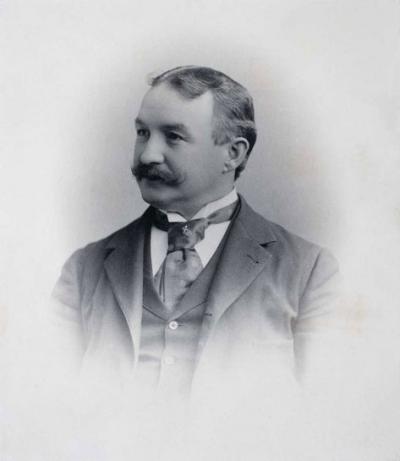The varied life of Mattapoisett's Francis Davis Millet
As many Mattapoisett residents know, painter Francis Davis Millet ("Frank" to his friends) was born in a house on Water Street that still stands, on November 3, 1848.
Millet, who would achieve fame for his paintings, particularly his murals, which decorated the Baltimore Customs House, Boston's Trinity Church, and the Capitol Buildings of Wisconsin and Minnesota.
However well known as an artist, Millet led a full and varied life until the very day of his death aboard the Titanic in 1912.
He was a Civil War veteran. Millet followed his father Asa, a respected surgeon, to the Civil War at the age of 15. He began as a drummer boy, and later became his father's surgical assistant, often performing grisly operations on the battlefield itself.
Millet was a journalist before he was an artist - and returned to journalism in his fifties. Millet graduated from Harvard in 1869, aged 21, with a degree in literature. He began a professional career working for the Boston Daily Advertiser and the Boston Courier (where he rose to the position of City Editor within two years). Furthermore, after establishing a brilliant career as an artist, Millet took back up the mantle of journalist at age 50, taking up a war correspondent position in the Philippines in 1898.
Art was originally just a hobby. Millet spent his off-hours as a journalist in Boston creating lithographs, a method of printing using a smooth limestone plate, oil and ink to easily transfer an image to paper. Finding himself interested in art, he entered the Royal Academy of Fine Arts in Antwerp, Belgium in 1871, at the age of 23.
While at the academy, Millet received a medal of academic excellence in 1872 and 1873, which was unprecedented at the time.
He had friends in high places. Millet married Elizabeth Merrill in Paris in 1879; his best man was none other than good friend Mark Twain.
He was a skilled medic. Although certainly not a qualified medic, Millet's abilities were useful on a battlefield. As a war correspondent in the 1877-1878 Russo-Turkish War, he often performed medical procedures on injured Russian soldiers. "His experience during the Civil War standing him in good stead, he even operated, amputating an arm at the shoulder joint; he had assisted his father in a similar operation and he never forgot anything once seen or learned," wrote his friend George W. Maynard, in a July 1912 memorial profile of Millet for "Art and Progress" magazine.
Millet was awarded two medals by the Russian government for his bravery in caring for wounded soldiers.
Millet was last sighted on the deck of the Titanic. He had boarded the doomed ship in Cherbourg, France, traveling first-class. Millet was traveling with good friend Archibald Butt, who was a military aide to President William Howard Taft.
When the ship hit an iceberg on April 14, 1912, an eyewitness account from a survivor placed Millett, Butt, and John Jacob Astor IV (the richest passenger on the Titanic) on deck, helping to load women and children into lifeboats.
There is no evidence of what happened next, but unverified accounts then say that the three men returned to the first-class drawing room, where they continued a card game as they awaited their fate. All three men perished in the disaster.
Millet was recognized upon personal items; he is buried in East Bridgewater's Central Cemetery. He was found to have had had plans for a mural at the New Bedford Library with him when he died.













